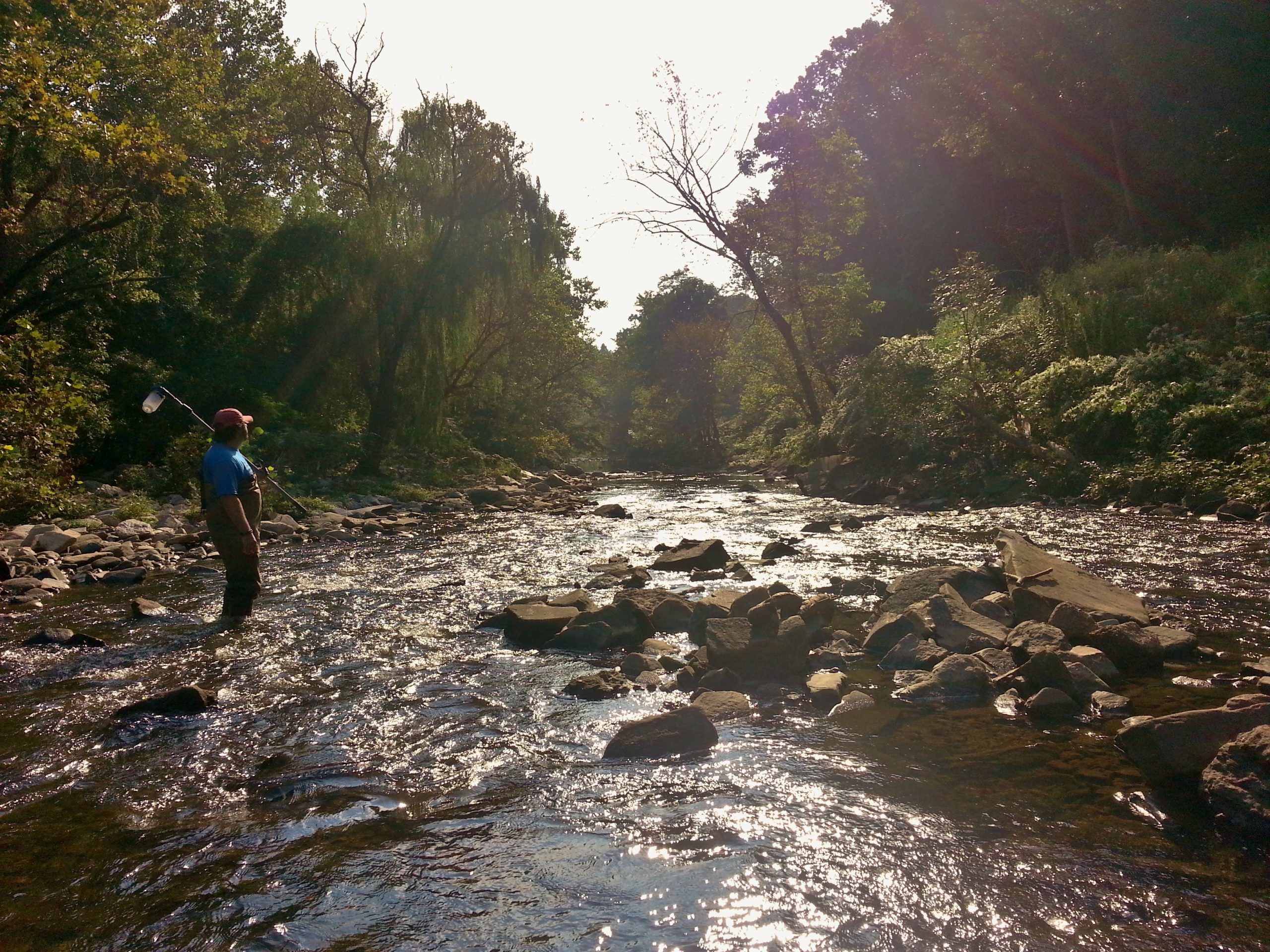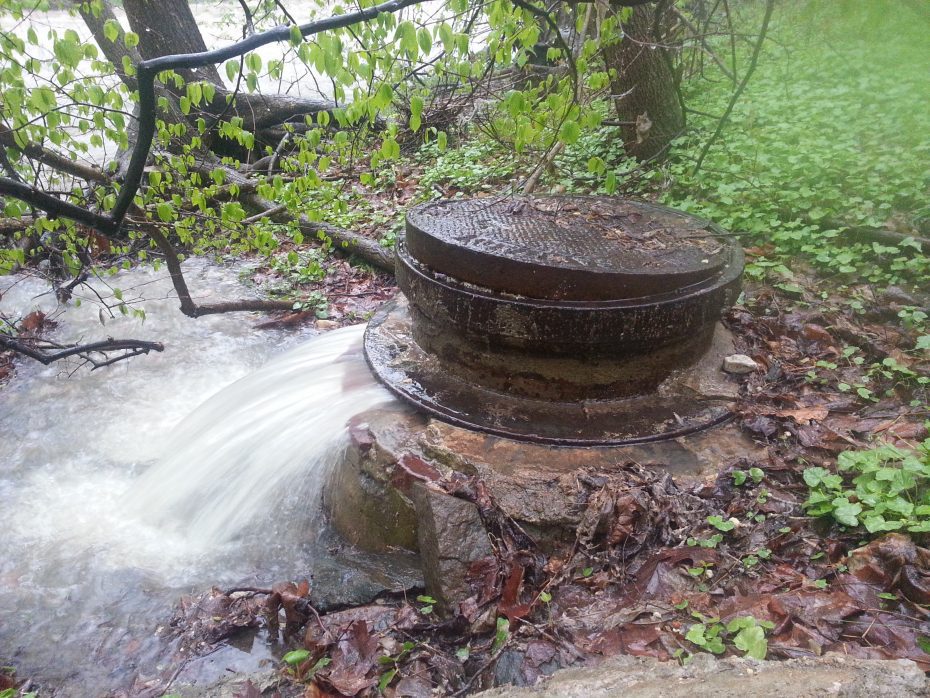
What is in our water? Are waterways in the Gwynns Falls watershed getting better or worse? What is causing these changes?
To answer these questions, Blue Water Baltimore joined forces with USGS and the Cary Institute of Ecosystem Studies through the Baltimore Urban Waters Partnership to analyze over 20 years of surface water quality data in the Gwynns Falls watershed. Researchers embarked on a comprehensive study aiming to find significant trends in water quality and pinpoint the most significant causes of these changes. From leaking sewage pipes to road salt, there are many different factors across the landscape that could be impacting water quality over time – but which ones are really effecting change in water quality, and which ones are just background noise? With a robust dataset, we can finally say which factors should be of greatest concern and how residents can take action.
The Gwynns Falls Trends Analysis Study
There are Chesapeake-Bay-wide assessments focused on tracking water health over a very large geographic area. However, until recently we didn’t information about how different factors such as water main breaks or sewage overflows are affecting the environment at the intermediate “watershed” scale. This is why the Gwynns Falls Trends Analysis study is so important – it has implications for other watersheds in our area, but it is localized enough that we can see how individual projects are making an impact on water quality.

Raw sewage mixed with storm water surges out of a damaged sewer manhole next to the Herring Run stream.
What Did We Find?
Looking at a variety of factors including sewer pipe repairs, sewage overflows, water main breaks, road salt application, and stormwater projects like bioswales and retention ponds researchers ran analyses on the different measurements of water health to determine if there were any significant changes to water quality over time. Then using statistical software they looked for relationships between the increases or decreases in water quality with individual factors. Three major conclusions came out of this study:
1) Stormwater Projects Appear to be Working
Stormwater best management practices are designed to slow down and reduce the amount of polluted rain water that enters our waterways. In an urban environment, projects like curb bump-outs and other green infrastructure are meant to reduce the amount of nutrients, bacteria, and sediment that flow into a stream by giving polluted stormwater a place to be filtered before it enters the larger stormwater pipe system. The study found that the area treated by these projects is significantly correlated with reductions in the total amounts of phosphorus, phosphate, and sulfate found in waterways throughout the Gwynns Falls watershed – which equates to cleaner, healthier water.
2) Sewage Overflows are Severely Degrading Water Quality
Raw, untreated sewage carries a host of pathogens that are harmful to human health, and it is also incredibly damaging to ecological health. The study showed that sewage overflows were directly linked increased levels of nitrate, phosphate, total nitrogen, total phosphorus, chloride, sulfate, bacteria, and ammonia. Sewage overflows have several different root causes. Sewer pipes that are blocked by grease balls and debris can cause sewage to back up in the pipe system, leading to raw undiluted sewage flowing out of street-level manholes and sewer stacks along stream banks. During heavy rain events, stormwater can infiltrate the sanitary sewer system through leaks and cracks in the pipes. Once this happens, there’s too much liquid in the pipes and the sewer/stormwater slurry backs up into the street and into peoples’ homes. In some cases, this slurry is discharged directly into our streams through several engineered “overflow” points in the collection system.
In comparison to stormwater, there is far less sewage entering our waterways by volume; there were over 17 million gallons of sewage overflows in Baltimore City in 2017, but an estimated 25 BILLION gallons of stormwater runoff. However, as we discovered through this study, sewage is degrading many more parameters of water quality than what stormwater projects are addressing. This means that we likely won’t see meaningful improvements to overall water quality until we end the flow of sewage into our waterways.
3) Climate Change is Happening in the Gwynns Falls Watershed
We can see climate change happening in the Gwynns Falls Watershed on a 20-year timescale. Statistically we’ve been getting more annual precipitation over time, and other research suggests this increase will continue. This trend is primarily driven by an increase in winter storms and rainfall, which is particularly problematic because the excess rainfall happens during a time of the year when stormwater projects that rely on plant beds to soak up extra water are least effective as those plants become dormant for the season. Increased precipitation also means increased stormwater infiltration into the sewage collection system, which could ultimately lead to more sanitary sewage overflows. This makes our investment in stormwater projects and sewer repairs even more important – the problem won’t go away on its own, and it will only become more costly to implement solutions the longer we wait. The good news is that despite the increase in annual precipitation, we are still seeing improvements in trends correlated with stormwater projects.

A full copy of the report can be downloaded here.
Listen to Blue Water Baltimore’s Lead Water Quality Scientist Alice Volpitta discuss the study and its significance on WYPR’s “The Environment in Focus.”
What Can You Do?
You can get involved in several ways:
- Help us improve the quality of stormwater runoff by picking up after your dog and not dumping anything into the storm drains.
- Don’t pour Fats, Oils, or Grease down the drain. FOG’s should be cooled, poured into a can, and thrown away in the trash. Grease can clog our sewer pipes and cause SSO’s.
- Reduce water usage during rain events. We know that stormwater infiltration is happening, but this will reduce the burden on our sanitary sewer system.
- Contact your City and County Council members to let them know that stormwater and sewer improvement projects are important to you.
- Stay engaged in the budgeting process; these projects need money, and your voice matters!
- Become a donating member of Blue Water Baltimore. Sign up to receive our emails so you can stay up to date on what’s going on and future opportunities.
- Attend a Pollution 101 training or an Outfall Screening Blitz event and report pollution to us if you see it.
- Sign up for a tree planting.
- Plant a rain garden – visit Herring Run nursery to learn more.
